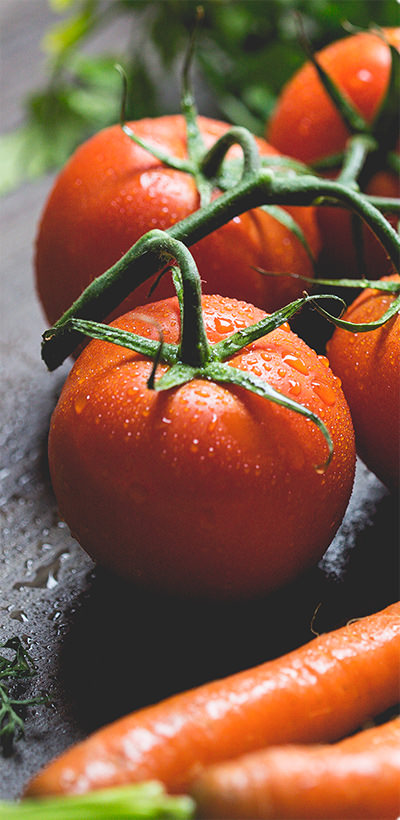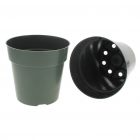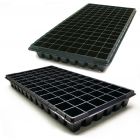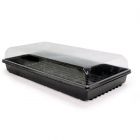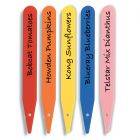Grow With Veseys Collection
This collection contains 3 pkgs, 1 each of Hampton Organic Lettuce, Little Birdy Red Robin Tomato and Matrix Jewel Pansy.
Hampton Organic Lettuce: Hampton is the perfect lettuce for a quick salad. With one easy cut, the leaves become unattached individually from each other and are ready to eat.
Little Birdy Red Robin Tomato: A member of the Little Birdy series, Red Robin is a compact, red, determinate cherry tomato. Plants are ideal for 5-6" pots or hanging baskets.
Matrix Jewel Pansy: Large-flowered pansies at their best that will put on an unmatched colour show for all to see. The Matrix series features a no-stretch habit that keeps them looking fabulous all summer, especially during the cool season. Great for pots or as a punch of colour in your landscape.
View our growing videos on Veseys Youtube Channel.

Details
Growing Information
Lettuce Planting:
Start indoors 4-6 weeks before last frost date for transplants. Direct seed in early spring, as seed will germinate between 40-80 degrees F. Sow thinly 1⁄4 inches deep. Spacing: Leaf types - 6 inches apart with 12 inches rows. Make succession plantings every 1-2 weeks to ensure a constant harvest.
Growing: Choose an area with full sun to partial shade and soil pH of 6.2-6.8. Lettuce is a heavy feeder and prefers a rich, well cultivated soil with good drainage. Some success can be expected even in poor soils using the loose-leaf types. Add plenty of compost or well-rotted manure prior to planting. Benefits from regular feedings with a nitrogen rich fertilizer. Mulching is useful to keep soil cool and reduce weeds.
Harvesting: Harvest lettuce early in the morning. Looseleaf types can be picked as soon as leaves are large enough to eat. Harvest head types when they are firm and well wrapped. If your lettuce becomes bitter during warm weather, wash and place in the fridge for a couple of days before eating.
Pests & Diseases: Distract insects by using row covers and companion planting. Rotenone and Trounce will control aphids, plant bugs and leaf hoppers. Slugs cherish lettuce; use slug bait to control slugs.
Companions: Most vegetables, carrot, garlic, onion and radish make the best companions.
Pansy Planting:
Start inside 8 weeks before planting out. Lightly cover seed, provide total darkness and normal room temperatures. Should germinate in 10-20 days. May also be direct seeded into the garden in early spring or early autumn. Transplant outside in early spring into a part shade location.
Growing: Only plant in full sun in areas with cool summers. Very frost tolerant and prefers cool, moist conditions. Provide rich, moist well-drained soil. A mulch is often helpful. Deadhead regularly to ensure that plants bloom all season. Self-seeds.
Tomato Planting:
Tomatoes are tender plants and are very susceptible to frost damage. Start seeds indoors 6-8 weeks before the last frost date in your area. Sow 1 seed in 1x1 inch cell. Cover seed with 1⁄4 inches soil and provide a constant soil temperature of 21-24°C.
After plants develop 1-2 sets of true leaves, transplant into 4-4.5” pots. Use a water-soluble fertilizer every two weeks.
Provide lots of light, 10-12 hours a day. Without sufficient light, seedlings will become tall and spindly. If you use a windowsill for your light source, be aware that it may get very hot on sunny days and very cold at night. Plants may dry out or get frost or heat damage. Turn containers frequently dissuading elongation.
Water when potting mix is dry to the touch. Feed regularly with any balanced vegetable tomato liquid fertilizer or organic equivalent. Feed once a week with half rate fertilizers or once every two weeks with full rate. You may also use a slow-release fertilizer especially for containers.
Moving Outside:
Gradually adjust your plants to outside conditions over a period of a week or two. First place them outside on a warm, calm day in the shade for a few hours. Work up to more sun, wind, and cooler temperatures and finally leave out overnight. Transplant outdoors after all danger of frost has passed. When transplanting, space 24-36” apart with rows at least 36-48” apart.
Growing:
Full sun location, with good air circulation. Soil should be well drained and fertile. Amend soil with compost or well-rotted manure prior to planting. Feed regularly during the growing season with compost tea or well-balanced liquid fertilizer or incorporate a pelleted fertilizer. Avoid excessive nitrogen, particularly before flower or fruit set. Provide even moisture during fruit set and development. Excessive watering can increase fruit size but decrease flavour.
Pruning:
Determinate Tomatoes are tomato plants with a set amount of growth and yield and do not require pruning. Determinate tomatoes typically do not require staking and produce all fruit at the same time.
Indeterminate Tomatoes will continue to grow and produce fruit until the first hard frost. Pruning removes unwanted growth and redistributes energy that would have been used for the unwanted growth in other areas of the plant like fruit production. Leaving indeterminate tomatoes unpruned is not detrimental to the plant’s health and growth. In fact, many gardeners do not prune their tomatoes and still get plentiful yields. By pruning, you are taking the next step in producing bigger and more flavourful tomatoes.
Harvesting:
Pick fruit firm but with a little give and when fruit is half coloured. Overripe tomatoes rot quickly. Tomatoes will ripen off the vine if there is any colour showing.
Pests & Diseases:
Protect from cutworms by using protective collars around the plant stem or place cornmeal around plant base. Blossom end rot (a brownish-black, sunken dead area that forms on the bottom of the fruit) is a condition caused by a calcium deficiency due to uneven watering. Blight, another disease common to tomatoes is caused by warm, humid conditions particularly if plants have not been given some support to keep foliage off the ground. Use copper or sulphur sprays to help prevent blight. Good air circulation along with proper rotation will help to prevent onset of this harmful disease.



